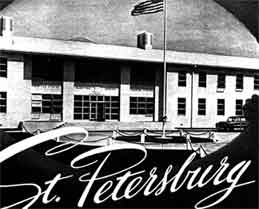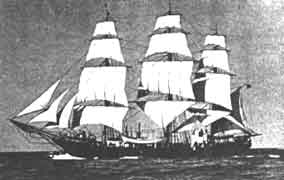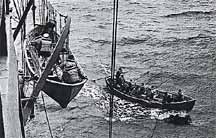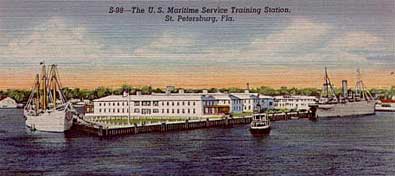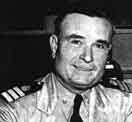U.S. Maritime Service Training Station
St. Petersburg, Florida
In September 1939, the Maritime Service inaugurated training as apprentice seamen for young American citizens between the ages of 18 and 23. The first class, now in training on board the Commission's training ships, the American Seaman and the Joseph Conrad, is composed of 250 young men selected from voluntary candidates who have been enrolled for at least 1 year with the Civilian Conservation Corps. These 2 vessels are now based at St. Petersburg, Fla., and will be joined shortly by the sailing vessel Tusitala which will be used as a station ship.The city of St. Petersburg, Fla., has tendered the Commission a strip of water-front property on which the apprentice seamens' training station will be erected as soon as the title to the property is perfected. Present plans call for the annual enrollment of 500 young men. During the 1-year course of training the first 3 months will be spent at the shore training station, the following 6 months on the training ships, and the last 3 months on active Coast Guard vessels.
United States Maritime Commission Report to Congress for the Period ended October 25, 1939
U.S. Maritime Service station has capacity for 4000 apprentice seamen...
men given practical sea experience aboard the sailing ship Joseph Conrad.
Like a Giant sea bird out of another world, she eased gracefully out of New York Harbor and headed for sea.
As she passed pier after pier crowds used to stare and admire. The hearts of oldtimers along the waterfront beat a little faster as they feasted their eyes on this proud beauty. They remembered when she and her sisters ruled the seas.
She was the JOSEPH CONRAD, the last surviving frigate in the world. A three-masted full-rigger, she had been built in 1882 in Denmark and for 52 years had been a training ship for the Danes.
Now she was going back to school and to war. The "Conrad" was no curio. She was not destined for any retirement. She was a ship with a mission.
Her departure from New York on the morning of November 2, 1939, was just a momentary oddity soon forgotten, hut she was enroute to a destination where a role of great significance awaited her in those tragic days of "too little and too late."
Her port was St. Petersburg, Florida, where she was to be one of the vanguard in the building of the largest (up to 4,000 men) and most modern training unit for Merchant Seamen on the southern coast of the United States. The "Conrad" was one of the first training vessels attached to the United States Maritime Service Training Station in St. Petersburg, Florida.
The old girl was particularly proud of her new assignment because a few years before she had been ticketed to be broken up when Alan Villiers, writer of sea stories, bought her at the last moment. Now that she was back at her old stand preparing men for the sea she would be pardoned if she flapped her sails proudly and said, "I'll show 'em."
She showed 'em during the early years of the present war when she helped produce her share of trained seamen to carry the goods to the farflung fighting fronts. She's still showin' 'em. The "Conrad" is an important part of the comprehensive and ever-developing maritime training devised to send men to sea.
A brief review of the activities of St. Petersburg Training Station will give an insight into the scope of this program.
First of all, there is a five-week preliminary training, followed generally by branch instruction in either deck or engine which ranges from three to eight weeks; practical ship training of from two to four weeks and three to five weeks of advanced courses.
A comprehensive Cooks and Bakers School was started in December, 1942, operating on a basis of five weeks preliminary training and eight to ten weeks advanced instruction. Initial classes were held aboard the training ship Tusitala.
Famous among the sailing ships of other days the Tusitala is 261 feet overall and 1200 gross tons. At one time she participated in the celebrated grain races held between Australia and England.
Her masts were cropped, decks cleared of sailing gear and she was towed into St. Petersburg to be tied up and used as a stationary training ship to augment class facilities. First classes held aboard this ship utilized the galley and mess room as class rooms for courses which included theory and practical instruction in cooking, baking, butchering, care and use of tools and equipment, sanitation, cooks and messmen duties at sea, and ship routine. In addition, there was instruction in boat drill, gunnery, physical education, regulations, customs and traditions.
Abandon Ship practiceDuring the summer of 1943, the Cooks and Bakers School was moved into the newly-completed station barracks to take up regular operation there in conjunction with the new galley. Peak graduation from the school was 345 cooks and 511 messmen in a single month.
Late last year, the station had grown to such proportions that it was necessary to take over downtown St. Petersburg hotels to handle the various types of training offered, particularly deck and engine cadets of the Army Transportation Corps Marine Officer's Cadet School, the most recently added training activity.
All trainees are given aptitude tests to determine their qualifications. Among the courses offered are: able seaman certification; promotional examinations for training station permanent crew members; remedial courses in mathematics for prospective radio school and Assistant Purser-Hospital Corps candidates, clinical courses in cooperation with the Medical Department, schooling for ship's carpenters and coal-burning firemen for Great Lakes shipping.
Any visit to St. Petersburg would not be complete without meeting "Barney" O'Kane, a large, gentle, black Labrador Retriever, and the station's mascot. "Barney" is a real seadog, being an adventurer and veteran of World War II. His master is Lt. Comdr. Leo D. O'Kane, USPHS, chief medical officer at St. Petersburg. Barney saw action in the Pacific and was present during the invasion of two Japanese-held islands. He proudly wears his campaign ribbons on his collar.
The number of floating units attached to the station has been steadily increased. The "Conrad" is used to teach deck; the Tusitala for cooks and bakers; two tugs, the Tickfaw and Morganza for coal burning firemen; the SS Vigil for deck and engine, and the USMSTS American Sailor for advanced training in all subjects.
View of Training Station from the sea. Vessel on left TV Tusitala, right is the TV Vigil
